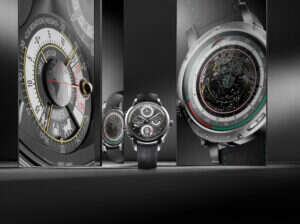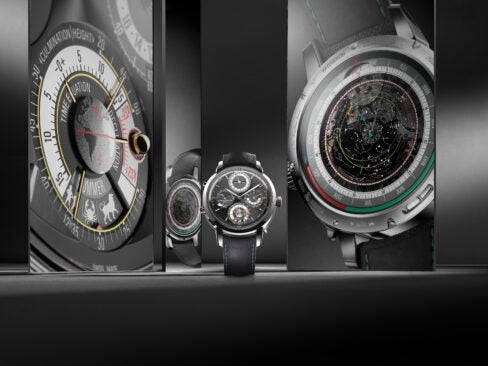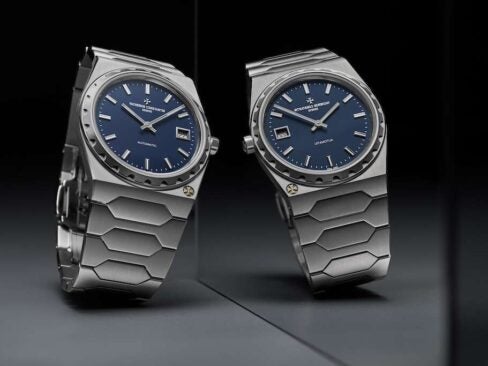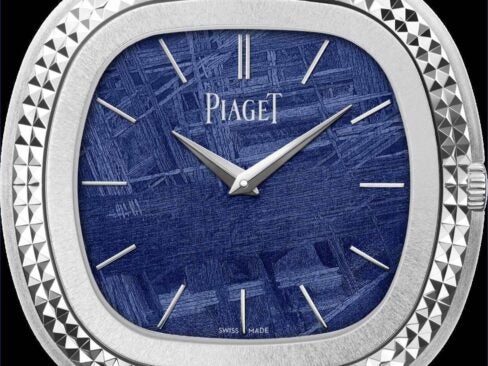By Zahra Al-Kateb
 The 14th Edition of the Grand Prix D’Horlogerie de Geneve is under way, and this year no less than 72 pre selected watches will be running to win the “Aiguille d’Or” Grand Prix.
The 14th Edition of the Grand Prix D’Horlogerie de Geneve is under way, and this year no less than 72 pre selected watches will be running to win the “Aiguille d’Or” Grand Prix.
With this year’s GPHG attracting record participation, all major watch groups are being represented, along with a number of independent companies.
Vote for your favorite amongst the following pre-selected watches and automatically participate in the drawing to win a Girard – Perregaux Vintage 1945 XXL Petite Seconde, worth $11372.29.
Here are the six finalists in the Striking caregory Tomorrow we will be revealing the Mechanical Exception category.
 BREGUET, CLASSIQUE LA MUSICALE
BREGUET, CLASSIQUE LA MUSICALE
The reference 7800 Classique “La Musicale” watch aroused a great deal of comment when it first came out, because apart from telling the time, it also houses a remarkable patented musical mechanism. Today the Breguet manufacturing company is happy to introduce a new version of this outstanding timepiece. This rose-gold watch is still fitted with Breguet’s self-winding 777 movement with a silicon escapement and balance spring. Yet when the button at 10 o’clock is pressed or when a set time has come, this Classique model plays Badinerie, composed by Johann Sebastian Bach as the final movement of his orchestral suite N°2 in B minor. This has been achieved with a mechanism similar to that of a musical box, except that instead of the traditional cylinder it has a disc with pegs that act successively on the 15 blades of the keyboard. A second innovation amplifies the sound so that the tune can be heard without sacrificing water resistance.
It is an engine-turned membrane in metallic glass fitted under the movement. Constant developments in acoustics at Breguet have enabled the intense research into the materials for the keyboard and membrane that would produce the best sound. The membrane allows the gold caseback to have a number of openings so as to create a Helmholtz resonator to broadcast the sound, while maintaining water resistance at 3 bar (30m). Finally, research progress in magnetism has led to Breguet fitting a magnetic governor for the melody. This patented system, which consists of isolated magnets in a cage, reduces unwanted sound while avoiding the wear found in conventional centrifugal governors. Above all it ensures that the melody proceeds at the right tempo.
The dial of this “La Musicale” Classique model shows the hours, minutes and seconds in the centre, with a power-reserve indicator at 3 o’clock and a visible indicator that the melody is playing between 9 and 10 o’clock. Such a work of art has to be immaculately turned out. Which is why the hands in traditional blued steel are open tipped in the Breguet style for the hours and minutes, while the seconds hands are in the “key of G” pattern. The dial is diamond-polished by hand to capture the light at different angles. While the music is playing, the dial, which is connected to the disc of pegs, rotates completely. During the 20 to 25 seconds of music, the engine-turned finishes make the dial come alive in shimmering colours. Furthermore an ingenious blocking system developed by Breguet ensures that there is always enough energy to play the entire tune.
As it did for the previous model, Breguet supplies the reference 7800 with a special box made of resonant wood. The alpine spruce, selected as the ideal tonewood by makers of stringed instruments, acts as a vibrant soundboard. This wood, which is found in the Risoud forest in the Joux Valley where the Breguet company is located, noticeably amplifies the music played in the watch.
As a work of art the “La Musicale” Classique model is in perfect keeping with Breguet’s values of elegant understatement, innovation and advanced methods. In addition, Breguet has been involved for a number of years in musical events such as the Geneva International Music Competition or New York’s Carnegie Hall. This timepiece thus underlines the brand’s connexion with music in particular and European art and culture in general.
Four hammers and gongs, a minute repeater and a Westminster chime. While this inventory of horological functions might already make an impression on watch connoisseurs, the picture is far from complete. Activated by an innovative repeater slide, the striking mechanism of Bvlgari’s new Grande Complication model L’Ammiraglio del Tempo, is presented with a detent escapement and a constant-force device; the latter is a regulating organ that embodies the ultimate level of horological complexity. The elaborate 516-part movement used in L’Ammiraglio del Tempo is housed within a case belonging to the Daniel Roth line. One particular element plays a specific role in the activation of the striking system: one of the lugs is, in fact, mobile and serves as a repeater slide that glides from 7 to 8 o’clock to trigger the minute repeater.
The Soprano features a musically accurate 4-note minute repeater striking Westminster Quarters on patented cathedral gongs, a 60-second tourbillon and Charles X style bridges, all on a spectacular dial-free view. The Soprano pays homage to the roots of Christophe Claret’s manufacture, which has innovated in striking complications, tourbillons and sapphire components since its earliest years. Indeed, in 1997 Christophe Claret was the first to incorporate sapphire components – comprising plates and Charles X style bridges − in a wristwatch movement.
The Soprano is a timepiece of contrasts: traditional haute horlogerie with state-of-the-art manufacturing; English Parliament with French King; historic complications with contemporary design; aural indications with visual displays; noble gold with high-tech titanium, and metal components with sapphire elements.
The minute repeater is considered – with good reason − to be one of the most demanding and difficult horological complications to realize due to the marriage of technical complexity with artistic musical tonality. A minute repeater tells the time audibly with two notes created from two small hammers striking two gongs: one for the hours, one for the minutes and a combination of the two for the quarter hours. Even more complex is the Clarion repeater with three notes that can play a simple melody for the quarters.
However, the nec plus ultra of the minute repeater realm is the Westminster – so called for the distinctive tune played by the Big Ben clock at the Palace of Westminster, home of the British Parliament. Big Ben strikes a complex melody for the quarters with four hammers striking four notes on four bells. To provide an even fuller and richer sound than standard repeaters, the Christophe Claret Soprano features four cathedral gongs, each circling the perimeter of the movement twice (a normal gong goes around only once). And to further ensure that the rich sound reaches the listen’s ears, the central case band is in grade 5 titanium, a metal known for its superior acoustic properties and used in musical instruments.
A few decades before Big Ben began chiming Westminster Quarters over London, the French king Charles X was making a significant impact on art, architecture and horology. One of the defining characteristics of pocket watches created during this period were stepped bridges, which became known as Charles X bridges. Having spent much of his early watchmaking career restoring beautiful timepieces from this epoch, Christophe Claret incorporated this historic design element into the Soprano.
 CLAUDE MEYLAN, LA RÉPÉTITION 5
CLAUDE MEYLAN, LA RÉPÉTITION 5
CLAUDE MEYLAN takes its inspiration from the great tradition of our Valley and creates « La Répétition 5 » in the L’ABBAYE line. With its pure and timeless curves associated with the romance of sounds, “La Répétition 5” introduces a new sculpture playing time.
Right in the centre of the piece, dressed with rhodium, the hour and minutes wheels bring the hands in an infinite Ballet. Expert artists have carefully and thoroughly carved the decors inspired by the most elegant ornamentation. Transparencies and reflections are playing with the mechanism and highlight the notes animation.
Each bridge is cut up, fully decorated by hand and arranged in such a way that it gives a fascinating transparency and light while sounds are cradling you.
La Répétition 5 gives you time without watching it ! The magic of the mechanism combined with the melodies take you to a new dimension where time becomes a space of your own and filled with your senses.
 HUBLOT, TOURBILLON CATHEDRAL MINUTE REPEATER
HUBLOT, TOURBILLON CATHEDRAL MINUTE REPEATER
Born of the desire to pursue an independent route enabling Hublot to design and produce its own movements, the brand has now unveiled its second Minute Repeater coupled with a tourbillon. Exhibiting a marvellous balance between the classic style of its two major complications, a symbol of watchmaking art, and the dynamic, modern design of the Classic Fusion 45 mm, this piece is a fine exercise in style that demonstrates the principle of fusion between Tradition and Modernity.
Entirely designed, developed and produced by the micro-mechanical engineers, engineers and watchmakers at Hublot, and this new Grande Complication is the result of 24 months of R&D. Fully remodelled and optimised since the first version appeared in 2010, the new Tourbillon Minute Repeater retains all of Hublot’s DNA.
The sapphire dial reveals the HUB 8001 hand-wound mechanical movement, with its tourbillon escapement and the Minute Repeater mechanism. Among the notable new features are the newly designed time setting function and a traditional tourbillon with its 13.6 mm diameter cage, which rotates once every minute, and boasts a highly stable construction thanks to the barrette on the dial side.
The assembly of its 319 components – bridges, cams and springs, racks and hammers, gongs and snails, cage, wheels, jewels, screws – is a unique decorative element in itself, beautifully complemented by the watch’s hands, which are red gold- or rhodium-plated, like the case.
One of the technical feats achieved on the Minute Repeater, whose construction requires a level of expertise possessed by only a small number of manufactures, is the complete integration of the trigger piece in the left-hand bezel lug of the Classic Fusion’s case. This means it is no longer an appendage – as is usually the case – but rather a cleverly integrated function which results in a watch with a particularly harmonious appearance.
The power of the double cathedral chime and the exceptional clarity of its tone has already brought it to the attention of connoisseurs. Finally, the Tourbillon Minute Repeater, which has a power reserve of 5 days, is water-resistant to 30 metres – a highly complex achievement at this level, and much sought after by connoisseurs. The sound of the chime no longer relies on airborne transmission, but rather resonates through the material of the case.
The watch has an aesthetically pleasing diameter of 45 mm. The piece looks beautiful in King Gold (extra-precious gold containing 5% platinum) or titanium, the two versions in which this new model is available. It is completed with a strap, with a deployant buckle, in black alligator leather sewn onto tone-on-tone rubber for comfort, flexibility and increased leather durability.
 URBAN JÜRGENSEN & SONNER, TOURBILLON MINUTE REPEATER REGULATOR
URBAN JÜRGENSEN & SONNER, TOURBILLON MINUTE REPEATER REGULATOR
The watch allows the user to call upon it to signal the time when desired. This is accomplished by pushing a sliding lever located on the side of the case at 9 o’clock, thus activating the chiming mechanism. The watch uses two gongs.
The term ‘regulator dial’ refers to the central position of the blued steel minutes hands in relation to a separate subdial for the passage of the hours. Thus, the visual main accent is on the minute hand in the center. The reason behind the term ‘regulator’ in this case refers to the connection with the word ‘regulation’. This uncluttered position of the minute hand made it easier to exactly set the watch to an exact observatory timekeeper and more visually efficacious in applications that required the close observation of the exact passage of minutes in scientific studies when compared to a standard watch format where the hour and minute hands work from the same central position. In this way, the popularity of the regulator style dial layout coincided directly with the advances made in science, business, medicine and industry during the course of the 19th century.
In the 21st century, the word ‘enamel’ is often thought to be synonymous with anything that is painted with a high gloss finish, even though this is far from the definition of the original craft. Even in the world of haute horology, enameling is oftentimes confused with the use of white or colored resins used on ceramic dials, as well as paints that require only a very low temperature, such as 150˚ or 160˚ C in order to fixate and harden. Linguistic mystification also plays a role with the coining of the term ‘cold enamel’ used to describe such work at low temperatures, whereas it has nothing to do with traditional enamel artisanry at all.
On the other hand the high fire temperature criteria (700° to 800°C) used in the “Grand Feu” technique is not the sole difficulty encountered in making high grade enamel dial. These high temperatures are required to allow the silica, ground into a fine powder and mixed into an emulsion, to melt, vitrify and take on its glass like, exceptional glow and depth. In addition to the precise firing techniques, many other aspects affect the creation of an enamel dial perfected created for our watches. Besides the complete hand painting of numbers and characters, during the final stages some four transparent crystal flint glass fondant layers are applied and individually fired. In between each firing all imperfections will be smoothed out of the transparent vitreous enamel. It is the application of these layers of transparent fondant, perfectly set with exact thickness over the entire surface, which creates the transparency, glow and depth of a perfect dial. Such work allows no shortcuts. For the dial maker, it is also a nerve-wracking process, since the possibility of the dial deforming or developing hairline cracks increases with the firing of each layer. One last step will see the dial undergo further grinding, lapping and polishing – all entirely executed by hand. Whereas most enamel dials are normally 0.8 – 1.2mm in thickness, the dial specially created for the Urban Jurgensen & Sønner Tourbillon Minute Repeater have been created with a thickness of a mere 0.65mm, an amazing technical feat only achievable by the greatest artisans of the enameler’s art












